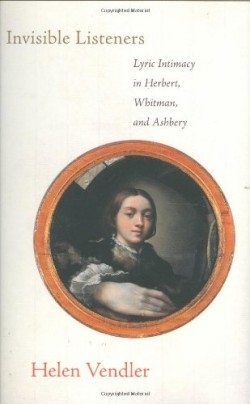
Invisible Listeners
Lyric Intimacy in Herbert Whitman and Ashbery
For serious readers of poetry, this author is its epicenter of literary criticism. Throughout her tenure at Harvard University as Professor of English, from thoughtful reviews to her several studies on Yeats, Stevens, Seamus Heaney, to an exhaustive exegesis of Shakespeare’s sonnets, she has been consistently intelligent and curious. She writes insightful yet modest interpretations in a style that once, before in-house academic jargons (Freud to Derrida to Paglia) took over of scholarship’s vocabulary, was called “a close textual reading.” This volume is a bit of a breather, being three Farnum Lectures that Vendler delivered at Princeton University, but it does in small what she has done before: to cogently explain the aesthetic and ethical resonance of lyric poetry.
These three poets, so dissimilar in style, nonetheless share a lyric poet’s plight of the confessional aria: that plaintive pronoun, a yearning I to a felt but silent you or we. Its conclusion, from this echo chamber of inevitable solitude, is always a one-sided conversation. The early seventeenth-century English poet George Herbert addressed his English and Latin verse to God, a devotional fervor not devoid of poetic craft or drama, for he both invokes Jesus and hears Jesus respond. Nineteenth-century über-American Walt Whitman, erotic, pantheistic, utterly modern still, addressed death itself, yet dared to foresee future readers and fellow travelers (most famously in “Song of Myself,” which ends, “If you want me again look for me under your bootsoles.”)
The inheritor of this complex lyric impulse toward revelation and self-knowledge is John Ashbery, whose 1975 long poem in the volume of the same name, Self-Portrait in a Convex Mirror, won the Pulitzer Prize for poetry. In it, the poet speaks to his surprising choice of a muse, the Renaissance painter Francesco Parmigianino, whose wooden sphere painting of his own mirrored reflection the poet first notices in a Vienna museum in 1959 (it is the portrait on the volume’s cover). Nothing is ever direct in Ashbery, but nothing is unnoticed either (everything has a surreal plausibility), and “Self-Portrait” becomes a long complicated address to the painter, in which he is beguiled by the artist’s novel handiwork, argues with the painter’s emotional perspective, and ultimately rejects its almost-Medusa like spell over his own future as a poet. It is a most tender and thoughtful exploration of the limits of poetic space, and Vendler does not stint its 552 lines, invoking both the aesthetic material (the mirror-like self-infatuation) with its ethical axis (how writing poetry changes the landscape of writer and reader).
In the full arc of her argument, Vendler makes a persuasive study: “These poets are the domesticators of the invisible, finding a language to confer materiality … on the otherwise unseen.” As poetry is not read but re-read, so Vendler’s handsome analysis should be, the art of engaged reading.
Reviewed by
Leeta Taylor
Disclosure: This article is not an endorsement, but a review. The publisher of this book provided free copies of the book to have their book reviewed by a professional reviewer. No fee was paid by the publisher for this review. Foreword Reviews only recommends books that we love. Foreword Magazine, Inc. is disclosing this in accordance with the Federal Trade Commission’s 16 CFR, Part 255.
